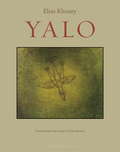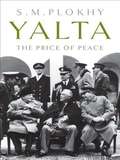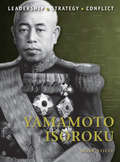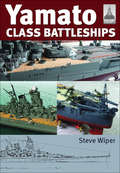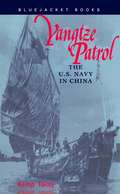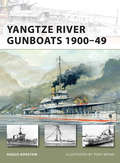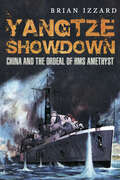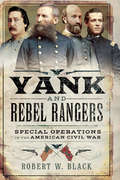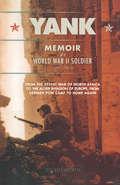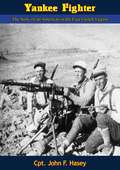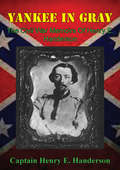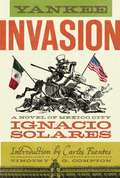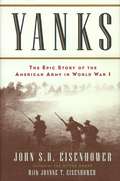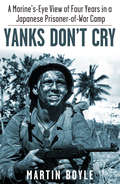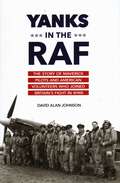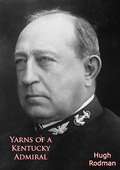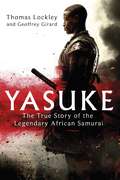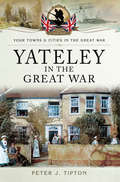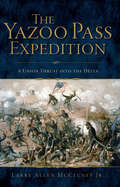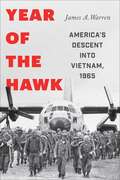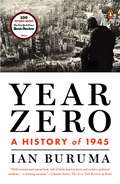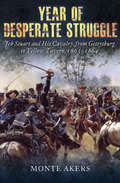- Table View
- List View
Yalo
by Peter Theroux Elias KhouryYalo propels us into a skewed universe of brutal misunderstanding, of love and alienation, of self-discovery and luminous transcendence. At the center of the vortex stands Yalo, a young man drifting between worlds like a stray dog on the streets of Beirut during the Lebanese civil war. Living with his mother who "lost her face in the mirror," he falls in with a dangerous circle whose violent escapades he treats as a game. The game becomes a horrifying reality, however, when Yalo is accused of rape and armed robbery, and is imprisoned. Tortured and interrogated at length, he is forced to confess to crimes of which he has little or no recollection. As he writes, and rewrites his testimony, he begins to grasp his family's past, and the true Yalo begins to emerge. Ha'aretz calls Yalo "a heartbreaking book . . . hypnotic in beauty."
Yalta: The Price of Peace
by S. M. PlokhyA major new history of the eight days in February 1945 when FDR, Churchill, and Stalin decided the fate of the world Imagine you could eavesdrop on a dinner party with three of the most fascinating historical figures of all time. <P><P>In this landmark book, a gifted Harvard historian puts you in the room with Churchill, Stalin, and Roosevelt as they meet at a climactic turning point in the war to hash out the terms of the peace. The ink wasn't dry when the recriminations began. The conservatives who hated Roosevelt's New Deal accused him of selling out. Was he too sick? Did he give too much in exchange for Stalin's promise to join the war against Japan? Could he have done better in Eastern Europe? Both Left and Right would blame Yalta for beginning the Cold War. <P>Plokhy's conclusions, based on unprecedented archival research, are surprising. He goes against conventional wisdom-cemented during the Cold War- and argues that an ailing Roosevelt did better than we think. Much has been made of FDR's handling of the Depression; here we see him as wartime chief. Yalta is authoritative, original, vividly- written narrative history, and is sure to appeal to fans of Margaret MacMillan's bestseller Paris 1919.
Yamamoto Isoroku
by Adam Hook Mark StilleAdmiral Yamamoto Isoroku was the defining Japanese naval commander of World War II. Although by no means part of the militarist clique that dominated Japanese politics in the 1930s, when war came Yamamoto was completely committed to his country's cause and planned and executed the daring pre-emptive strike on Pearl Harbor that so damaged the US Pacific Fleet and ushered in the Pacific War.Yamamoto's career in the Imperial Japanese Navy started in the early years of the 20th century and he saw service in the Russo-Japanese War, being wounded in the battle of Tsushima in 1904, before going on to study at Harvard University and serve as a naval attaché in the inter-war years, an experience that was supposed to give him a unique insight into the American psyche. Despite his opposition to the Japanese invasion of Manchuria in 1931 and war with China in 1937, as well as the tripartite pact with Germany and Italy, he retained his position as commander-in-chief of the combined fleet in the warlike Tojo administration and was it was in this position that he led the IJN to war in 1941.Despite the success of the Pearl Harbor operation, Yamamoto's subsequent handling of the Japanese combined fleet can be called into question. Seeking a 'decisive battle' against the US Pacific Fleet, Yamamoto took up an aggressive position in the Pacific and fought the US Navy at the battle of the Coral Sea in May 1942 and the battle of Midway. Midway can be said to be Yamamoto's 'hour of destiny' as he planned and executed the battle. Though unaware that the Japanese Naval code had been broken, he fatally divided his forces, leaving them vulnerable to piecemeal destruction. The final campaign commanded by Yamamoto was that around Guadalcanal, where Yamamoto's myth of excellence will be totally laid bare. Despite a considerable numerical advantage over the Americans, Yamamoto never brought this advantage to bear. The result was a devastating defeat for the IJN and, eventually, the death of Yamamoto himself.This title will use these key campaigns to analyze Yamamoto's command style and strategies, and assess how these impacted upon the course of the war in the Pacific and Japan's chances for success.
Yamamoto: The Man Who Planned Pearl Harbor
by Edwin P. HoytThe first major biography of the Japanese admiral who was the architect of the Pacific War and of the Pearl Harbor attack.
Yamato Class Battleships: Ijn Yamato Class Battleships (ShipCraft)
by Steve WiperThe Japanese Imperial Navy&’s impressive but ill-fated WWII battleships are examined in detail in this fully illustrated modeling guide. The volume in the ShipCraft series offers in-depth information about building and modifying model kits of WWII Japan&’s Yamato-class battleships. These were the largest warships of the Second World War and the largest battleships ever constructed. They also carried the largest naval artillery ever fitted to a warship. And yet, neither Yamato nor her sistership Musashi made much impact on the War. Musashi was sunk during the battle of Leyte Gulf while Yamato, deployed in a deliberate suicide attack on Allied forces at the battle of Okinawa, was finally sunk by US carrier-based aircraft. This lavishly illustrated volume takes the modeler through a brief history of the Yamato class, then provides step-by-step instruction for building a highly accurate model. Also included are hints on modifying and improving the basic kits and information on paint schemes. The strengths and weaknesses of available kits of the ships are reviewed, and the book concludes with a section on further research references.
Yangtze Patrol
by Kemp TolleyIn this entertaining history of the Yangtze Patrol, Tolley gives a lively presentation of the Chinese political situation over the past century and describes the bombing of the Panay, the siege of Shanghai, the battle of Wanhsien, and the Nanking incident. He also offers a liberal serving of colorful anecdotes and numerous period photographs.
Yangtze River Gunboats 1900-49
by Tony Bryan Angus KonstamFrom the end of the 19th century through the first half of the 20th, most Western powers maintained a naval presence in China. These gunboats protected traders and missionaries, safeguarded national interests, and patrolled Chinese rivers in search of pirates. It was a wild, lawless time in China as ruthless warlords fought numerous small wars to increase their power and influence. This book covers the gunboats of all the major nations that stationed naval forces in China, including America, Britain, France, Germany, Italy, Portugal, and Japan, and looks at such famous incidents as the Japanese bombing of the USS Patay and the dramatic escape of the HMS Amethyst from Communist forces in 1947, which marked the end of the gunboat era.
Yangtze Showdown: China and the Ordeal of HMS Amethyst
by Brian IzzardTells the &“epic tale of the entrapment of HMS Amethyst by the Chinese Communists . . . a good sea story and a look inside the early days of the Cold War&” (Strategy Page). The attack on the British frigate Amethyst on the Yangtze River by Chinese Communists in 1949 made world headlines. There was even more publicity when the ship made a dramatic escape after being trapped for 101 days. Eulogized by the British as an example of outstanding courage and fortitude, the &“Yangtze Incident&” was even made into a feature film, which depicted the ship and her crew as innocent victims of Communist aggression. The truth was more complex, and so sensitive that the government intended that the files should be closed until 2030. However, these have now been released and in making use of these documents this book is the first to tell the full story. What emerges is an intriguing tale of intelligence failure, military over-confidence and a hero with feet of clay—it is by no means as heroic as the well-publicized official version, but every bit as entertaining. While the reputations of diplomatic and naval top brass take a knock, the bravery and ingenuity of those actively involved shines even more brightly. Written with verve and including much new and surprising information, this book is both enjoyable and informative. &“[A] masterly work . . . gripped with tension and it is hard to put down . . . the feat of legends which will forever be celebrated throughout the endless history of the Royal Navy.&”—Australian Naval Institute &“A classic piece of post war naval adventure in a highly readable and well researched manner.&”—Scuttlebutt
Yank and Rebel Rangers: Special Operations in the American Civil War
by Robert W. BlackThis Civil War history reveals the tactics and covert operations of both Union and Confederate rangers, guerilla forces, and volunteer units. The major battles of the American Civil War are well recorded. But while much has been written about the action at Shiloh and Gettysburg, far less is known about the cover operations and irregular warfare that were equally consequential. Both the Union and Confederate armies employed small forces of highly trained soldiers for special operations behind enemy lines. In Yank and Rebel Rangers, historian Robert W. Black tells this untold story of the war between the states. Skilled in infiltration, often crossing enemy lines in disguise, these warriors went deep into enemy territory, captured important personnel, disrupted lines of communication, and sowed confusion and fear. Often wearing the uniform of the enemy, they faced execution as spies if captured. Despite these risks, and in part because of them, these warriors fought and died as American rangers.
Yank: Memoir of a World War II Soldier (1941-1945) - From the Desert War of North Africa to the Allied Inv
by Ted EllsworthTed Ellsworth was a young Dartmouth grad in 1941. In the years before the U. S. joined the Second World War effort, American men who wished to fight against Hitler were granted permission from President Roosevelt and the U. S. Congress to join the British army. <P><P>In normal circumstance, fighting for another nation's army would be an automatic forfeiture of U. S. citizenship (as noted on U. S. passports). Yank begins with goodbyes to Ellworth's young wife and family. It covers his crossing to Britain, initial stay in London, assignment to a North African tank regiment and the campaign there, participation in the invasion of Italy and the second wave of D-Day, accounts of fierce battles, being taken prisoner by the Germans and shipped to a POW camp, the camp deprivations, liberation by the Russians, and finally, the year Ellsworth spent wandering eastern Europe with no dog-tags, after the war had ended, trying to reach a city from which he could ship back home. Ellsworth had been officially MIA for over two years, and everyone assumed he was dead. The final pages detail Ellsworth's homecoming when his wife hand-delivers the beautiful and intimate note that she'd written him when he was first reported missing.
Yankee Fighter: The Story of an American in the Free French Legion
by Cpt. John F. Hasey Joseph F. DinneenThis is the true story of Jack Hasey, an American captain in the Free French Foreign Legion during the Second World War, who was critically wounded during the Battle of Damascus in June 1941.His bravery earned him the Order of the Cross of Liberty, the Croix de guerre 39-45 with four citations, and the Insignia for the Military Wounded. He became a Knight of the Légion d’honneur and received France’s highest World War II honour of all when he was named Companion of the Ordre de la Libération.
Yankee In Gray: The Civil War Memoirs Of Henry E. Handerson
by Captain Henry E. HandersonHenry E. Handerson, a tutor from the Western Reserve of Ohio, fifteen miles east of Cleveland, enlisted in the Confederate army on June 17, 1861...Handerson was not an ordinary soldier. His memoir is the account of a Northerner--who after only two years of residency in antebellum Louisiana decided to cast his lot with the Confederacy. ...Already a member of a local home guard company, the twenty-four-year-old Ohio-born Handerson was quickly enrolled as a private in the Stafford Guards, later Company B, of the Ninth Louisiana Infantry. The Ninth was first bloodied at the Battle of Front Royal, Virginia, on May 23, 1862, in a brisk fight with the Union First Maryland Infantry. As part of Stonewall Jackson's command, the regiment and Handerson marched and fought up and down the length of the Shenandoah Valley before moving down to Richmond to participate in the bloody Seven Days Battle. Handerson took part in the Fredericksburg battle, and later in the spring of 1863, was wounded in the neck at Chancellorsville. Lieutenant Handerson recovered from his wound just in time to reach Gettysburg on the last day of the battle there. In the Battle of the Wilderness, while carrying a dispatch, Handerson ran into an advancing battle line and was taken prisoner...and confined under poor living conditions, in a stockade in the direct line of fire from the Confederates at Charleston. Surviving this ordeal, Handerson wound up the war at Fort Pulaski, Georgia.Handerson's memoirs and his letters give a sympathetic picture of war and life in the Confederate army as seen through the eyes of a Northerner who lacked the emotional involvement of the native-born Southerners. His account of service with the army of Northern Virginia and as a prisoner of war is of particular value regarding the everyday details and incidents of a soldier's life. Important figures and Confederate heroes are treated fairly but objectively by this keen-eyed observer.-Edward Cunningham
Yankee Invasion
by Carlos Fuentes Ignacio Solares Timothy G. ComptonYankee Invasion centers on one of the most traumatic periods of Mexican history: the 1847 invasion of Mexico City by American armed forces and the ultimate loss of almost half its territory to the United States. Abelardo, who as a young man witnessed the events, narrates the novel and in its very first pages commits an act of resistance that will haunt him the rest of his life. In his old age, he begins to reflect on the history of Mexico, as well as his complicated love affairs with both his fiancée and her mother, which play out against the tumultuous backdrop of the invasion and occupation. Told with humor and pathos, Yankee Invasion paints a riveting portrait of an event that, though little known in America, still reverberates in Mexico today. Vivid descriptions capture the streets, cafés, cantinas, and drawing rooms of 19th-century Mexico City.
Yankee Stranger (The\williamsburg Novels Ser. #2)
by Elswyth ThaneLOVE AND WARCabot Murray first came to Williamsburg, Virginia, in the tense autumn of 1860. He was looked upon with suspicion because he was a Yankee. Then Cabot met redheaded Eden Day.Theirs was a wild, blind young love at first sight. Whispering in her hair, what did it matter that he was a Northerner and she from the South…But then came the Civil War. With the tide of battle Cabot returned as an enemy spy. In Eden he found the hatred of a woman who has learned desire.Could the bitterness of war be softened in the arms of lovers?
Yanks
by John EisenhowerFought far from home, World War I was nonetheless a stirring American adventure. The achievements of the United States during that war, often underrated by military historians, were in fact remarkable, and they turned the tide of the conflict. So says John S. D. Eisenhower, one of today's most acclaimed military historians, in his sweeping history of the Great War and the men who won it: the Yanks of the American Expeditionary Force. Their men dying in droves on the stalemated Western Front, British and French generals complained that America was giving too little, too late. John Eisenhower shows why they were wrong. The European Allies wished to plug the much-needed U.S. troops into their armies in order to fill the gaps in the line. But General John J. "Black Jack" Pershing, the indomitable commander of the AEF, determined that its troops would fight together, as a whole, in a truly American army. Only this force, he argued -- not bolstered French or British units -- could convince Germany that it was hopeless to fight on. Pershing's often-criticized decision led to the beginning of the end of World War I -- and the beginning of the U.S. Army as it is known today. The United States started the war with 200,000 troops, including the National Guard as well as regulars. They were men principally trained to fight Indians and Mexicans. Just nineteen months later the Army had mobilized, trained, and equipped four million men and shipped two million of them to France. It was the greatest mobilization of military forces the New World had yet seen. For the men it was a baptism of fire. Throughout Yanks Eisenhower focuses on the small but expert cadre of officers who directed our effort: not only Pershing, but also the men who would win their lasting fame in a later war -- MacArthur, Patton, and Marshall. But the author has mined diaries, memoirs, and after-action reports to resurrect as well the doughboys in the trenches, the unknown soldiers who made every advance possible and suffered most for every defeat. He brings vividly to life those men who achieved prominence as the AEF and its allies drove the Germans back into their homeland -- the irreverent diarist Maury Maverick, Charles W. Whittlesey and his famous "lost battalion," the colorful Colonel Ulysses Grant McAlexander, and Sergeant Alvin C. York, who became an instant celebrity by singlehandedly taking 132 Germans as prisoners. From outposts in dusty, inglorious American backwaters to the final bloody drive across Europe, Yanks illuminates America's Great War as though for the first time. In the AEF, General John J. Pershing created the Army that would make ours the American age; in Yanks that Army has at last found a storyteller worthy of its deeds.
Yanks Don't Cry
by Martin BoyleYanks Don't Cry, first published in 1963, opens on the tropical Pacific island of Guam in early December, 1941, a few short days before the attack on Pearl Harbor. The U.S. Marines on Guam, neither equipped nor prepared for an invasion are quickly captured and shipped off to prison in Japan. There they began a nearly four-year imprisonment until the war's end in 1945. During those years they managed to retain the high spirits of free men, to sabotage the Japanese war effort at every opportunity as they worked on the docks and in other areas, to steal extra food rations, and, near war's end, to observe with pride the American bombing raids on Japan (while struggling mightily to free a group of Japanese schoolchildren trapped in a warehouse damaged by the bombs). The author's sense-of-humor shines through on nearly every page, which allowed him and his companions a small measure of comfort and the strength to somehow carry on. Yanks Don't Cry remains a classic recounting of life in war-time Japan for Allied prisoners-of-war.
Yanks in the RAF: The Story of Maverick Pilots and American Volunteers Who Joined Britain's Fight in WWII
by David Alan JohnsonThis is the story of American volunteer pilots who risked their lives in defense of Britain during the earliest days of World War II-more than a year before Pearl Harbor, whenthe United States first became embroiled in the global conflict. Based on interviews, diaries, personal documents, and research in British, American, and German archives, the author has created a colorful portrait of this small group who were our nation's first combatants in World War II. As the author's research shows, their motives were various: some were idealistic; others were simply restless and looking for adventure. And though the British air force needed pilots, cultural conflicts between the raw American recruits and their reserved British commanders soon became evident. Prejudices on both sides and lack of communication had to be overcome. Eventually, the American pilots were assembled into three squadrons known as the Eagle squadrons. They saw action and suffered casualties in both England and France, notably in the attack on Dieppe. By September 1942, after America had entered the war, these now experienced pilots were transferred to the US air force, bringing their expertise and their British Spitfires with them. As much social as military history, Yanks in the RAF sheds new light on a little-known chapter of World War II and the earliest days of the sometimes fractious British-American alliance.
Yarns of a Kentucky Admiral
by Hugh RodmanHugh Rodman, a graduate of the Naval Academy, Class of 1880, is best known as the commander of the U.S. Navy's Battleship Division 9, that served in the North Sea in World War I as Battle Squadron 6, an integral part of the British Grand Fleet; after the war he was Commander-in‑Chief of the U. S. Navy's Pacific Fleet.
Yasuke: The true story of the legendary African Samurai
by Geoffrey Girard Thomas LockleyWARRIOR. SAMURAI. LEGEND.The remarkable life of history's first foreign-born samurai, and his astonishing journey from Northeast Africa to the heights of Japanese society.The man who came to be known as Yasuke arrived in Japan in the 16th century, an indentured mercenary arriving upon one of the Portuguese ships carrying a new language, a new religion and an introduction to the slave trade. Curiously tall, bald, massively built and black skinned, he was known as a steadfast bodyguard of immense strength and stature, and swiftly captured the interest, and thence the trust, of the most powerful family in all of Japan. Two years later, he vanished.Yasuke is the story of a legend that still captures the imagination of people across the world. It brings to life a little known side of Japan - a gripping narrative about an extraordinary figure in a fascinating time and place.
Yateley in the Great War (Your Towns & Cities in the Great War)
by Peter J. TiptonThere were fewer than 500 houses in Yateley in WWI but with Aldershot, Farnborough, Camberley and Sandhurst close by, this Hampshire villages response to the call to arms was more prepared than most, and punched above its weight.Using contemporary evidence from many sources researched by our local history team, the Yateley Society recreates the impact of the War on our predecessors. The story of the men who left Yateley to fight -- territorials, regulars, volunteers and conscripts -- is told alongside that of the battalions of Kitcheners New Armies training in trench warfare on Yateley Common. At the same time, in the three private houses forming the Yateley Military Hospital, Yateley women of all ages were tending wounded soldiers.With its intimate glimpses into village life, this book, will fascinate anyone with Yateley connections. The names of many families in the village of 100 years ago are here, while for recent newcomers with perhaps a Victorian or Edwardian house there may be clues to the history of your homes.With its many illustrations and maps, this exploration of the social network, and social consequences of the Great War on a small community in North East Hampshire has interest for historians and general readers alike.
Yazoo Pass Expedition, The: A Union Thrust into the Delta (Civil War Series)
by Larry Allen Jr.After six failed attempts to reach Vicksburg, General Ulysses S. Grant developed a plan. The Yazoo Pass Expedition was a Union army/navy operation meant to bypass Vicksburg by using the backwaters of the Mississippi Delta. Operations began on February 3, 1863, with a levee breach on the Mississippi River. The expedition was delayed as a result of natural obstacles and Confederate resistance, which allowed the Confederate army under Lieutenant General John Pemberton to block passage of the Federal fleet. The Confederates continued to rebuff the fleet and finally defeated it in the spring. Larry McCluney examines the expedition from start to finish in never-before-seen detail.
Year Of The Hawk: America's Descent into Vietnam, 1965
by James A. WarrenFrom a celebrated military historian, a powerful account of the most pivotal year of the Vietnam War—the cataclysm that forever changed America.The Vietnam War was the greatest disaster in the history of American foreign policy. The conflict shook the nation to its foundations, exacerbating already deep cleavages in American society, and left the country baffled and ambivalent about its role in the world. Year of the Hawk is a military and political history of the war in Vietnam during 1965—the pivotal first year of the American conflict, when the United States decided to intervene directly with combat units in a struggle between communist and pro-Western forces in South Vietnam that had raged on and off for twenty years. By December 1965, a powerful communist offensive had been turned back, and the US Army had prevailed in one of the most dramatic battles in American military history, but nonetheless there were many signs and portents that US involvement would soon slide toward the tipping point of tragedy. Vividly interweaving events in the US capital with action in Southeast Asia, historian James A. Warren explores the mindsets and strategies of the adversaries and concludes that, in the end, Washington was not so much outfought in Vietnam as outthought by revolutionaries pursuing a brilliant protracted war strategy. Based on new research, Year of the Hawk offers fresh insight into how a nationalist movement led by communists in a small country defeated the most powerful nation on earth.
Year Zero: A History of 1945
by Ian BurumaA marvelous global history of the pivotal year 1945 as a new world emerged from the ruins of World War IIYear Zero is a landmark reckoning with the great drama that ensued after war came to an end in 1945. One world had ended and a new, uncertain one was beginning. Regime change had come on a global scale: across Asia (including China, Korea, Indochina, and the Philippines, and of course Japan) and all of continental Europe. Out of the often vicious power struggles that ensued emerged the modern world as we know it.In human terms, the scale of transformation is almost impossible to imagine. Great cities around the world lay in ruins, their populations decimated, displaced, starving. Harsh revenge was meted out on a wide scale, and the ground was laid for much horror to come. At the same time, in the wake of unspeakable loss, the euphoria of the liberated was extraordinary, and the revelry unprecedented. The postwar years gave rise to the European welfare state, the United Nations, decolonization, Japanese pacifism, and the European Union. Social, cultural, and political "reeducation" was imposed on vanquished by victors on a scale that also had no historical precedent. Much that was done was ill advised, but in hindsight, as Ian Buruma shows us, these efforts were in fact relatively enlightened, humane, and effective.A poignant grace note throughout this history is Buruma's own father's story. Seized by the Nazis during the occupation of Holland, he spent much of the war in Berlin as a laborer, and by war's end was literally hiding in the rubble of a flattened city, having barely managed to survive starvation rations, Allied bombing, and Soviet shock troops when the end came. His journey home and attempted reentry into "normalcy" stand in many ways for his generation's experience.A work of enormous range and stirring human drama, conjuring both the Asian and European theaters with equal fluency, Year Zero is a book that Ian Buruma is perhaps uniquely positioned to write. It is surely his masterpiece.
Year in Nam: A Native American Soldier's Story
by Leroy TecubeRecollections from a Native American about the year that he spent in Vietnam during the Vietnam War, and how it influenced him throughout his life
Year of Desperate Struggle: Jeb Stuart and His Cavalry, from Gettysburg to Yellow Tavern, 1863–1864
by Monte AkersThis chronicle of the legendary Confederate Army of Northern Virginia brings vivid detail and insight to the campaigns of Maj. Gen. Jeb Stuart. By the summer of 1863, following the Southern victory at Chancellorsville, it was clear to everyone on both sides of the Civil War that the Army of Northern Virginia was the most formidable force Americans had ever put in the field. Much of that army&’s success was attributable to its cavalry arm, led by Maj. Gen. J.E.B. &“Jeb&” Stuart. But while Stuart could literally run rings around the enemy, Union arithmetic and expertise were gradually catching up. In Year of Desperate Struggle, author Monte Akers tracks Stuart and his cavalry from Gettysburg to the Overland Campaign, concluded only when Jeb himself succumbed to a gunshot wound at the gates of Richmond. It was a year of grim casualties and ferocious fighting—in short, a year of desperate struggle with the gloves off on both sides. In this sequel to Year of Glory, historian Monte Akers provides a minute examination of Stuart&’s cavalry during the controversial Gettysburg campaign, followed by nine months of sparring, during which the Union Army of the Potomac declined to undertake further thrusts against Virginia. After Stuart&’s death, the Army of Northern Virginia would eventually be cornered, but while he was alive, it was often the Northerners who most needed to look to their security.
